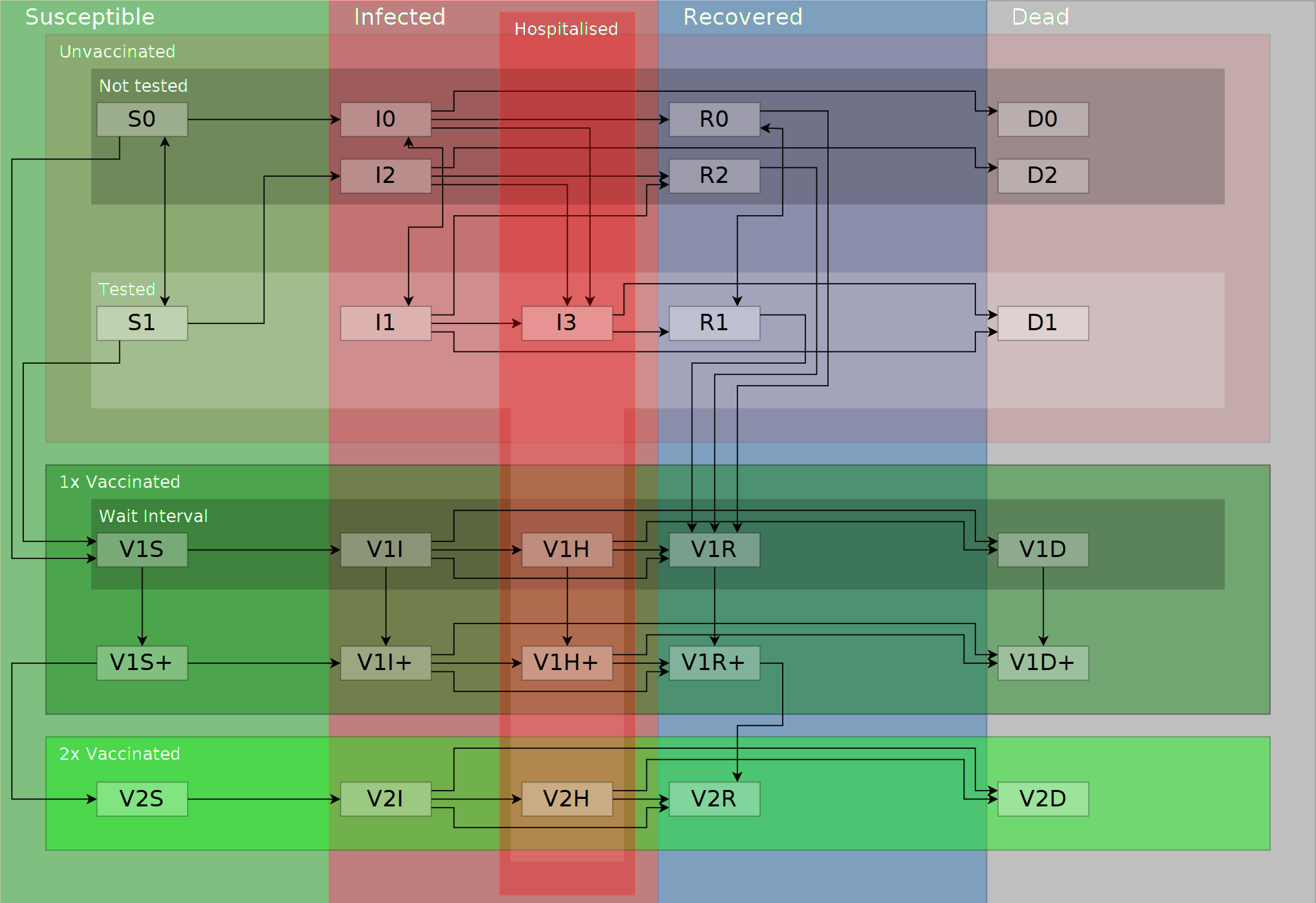Model / Algorithm

SIRD-Model
- S: Susceptibles, people that have not contracted the virus
- I: Infected, people that have contracted the virus
- R: Recovered, people that have recovered from the virus
- D: Dead, people that have died because of the virus
Gillespie-Algorithm
To realise the simulation a fitting stochastic algorithm is needed. The Gillespie-Algorithm simulates a model in a predefined time interval, e.g. one day, or until a certain state in the model is reached.The model is based on a predefined set of reaction rates and rules. New rules and rates are easily added too. The randomness comes from two randomly generated float-numbers.
Gillespie-Algorithm Steps
- Generate two random floats r1, r2 ∈ [0,1]
- Calculate reaction rates, the total sum and the cumulative sum of the reaction rates
- Advance the time t=t+Δt, Δt is in dependence of r1/TotalRateSum , r1 can be modified by a function, e.g. -log(r1), so that the number of events better fit the desired time frame.
- Divide every value of the cumulative sum by the total sum to place it on the interval [0,1]
- Determine the rule that will be executed with the second float by placing it into the cumulative sum interval
- Execute the rule
- Repeat until time limit is reached or desired model state is reached
Gillespie-Rules for my extended SIRD (excerpt, not all listed)
ι infect rate of the disease, N the sum of people, ρ the recovery rate, δ the death rate, η hospitalisation rate, ω vaccination rate, V available vaccination doses, ϑ testing rate, λ loss of testing rate- I: A susceptible gets infected: S+I → 2I with rate (ι/N)SI
- R: An infected recovers: I → R with rate ρI
- D: An infected dies: I → D with rate δI
- H: An infected gets hosptialised: I0 → I3 with rate η((Bmax-I3)/N)I0
- V: A susceptible gets vaccinated: V + S → V1S with rate ωVS
- T: An unvaccinated susceptible gets tested S0 → S1 with rate ϑS0.
A tested susceptible loses the test status S1 → S0 with rate λS1
 Each federal state of Germany has this model. This enables commuting of people between neighboring states.
Before the first Gillespe-Event takes place, commuters get distributed to the neighboring states. After the
last Gillespe-Event the commuters come home. The commuting individuals get sorted into their respective
category and influence the events happening at the visiting state.
Each federal state of Germany has this model. This enables commuting of people between neighboring states.
Before the first Gillespe-Event takes place, commuters get distributed to the neighboring states. After the
last Gillespe-Event the commuters come home. The commuting individuals get sorted into their respective
category and influence the events happening at the visiting state.

Assumptions made when creating this model
- Once recovered, no reinfection possible
- Every individual is willing to be vaccinated
- Individuals will not be vaccinated while infected
- Individuals in the hospital are always tested
- Positive tested individuals are less likely to infect others than non-tested infected
- Individuals with unknown status change aren't tested again
- Commuters commute before the first Gillespie-event takes place and go back home after the last
- Positive tested individuals don't commute, 1x Vaccinated individuals inside the wait period also don't commute
- Commuters are not able to be hospitalized
- Vaccination of commuters only possible in their own federal state
- Tests are able to determine if a person was already infected
- For each death it gets determined if the cause was the disease or not
